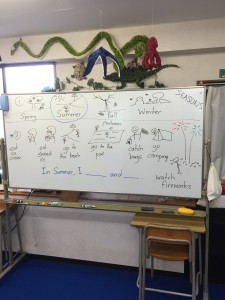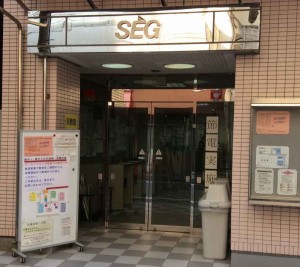Freestyle warmups for children’s classes
Recently I have been doing these kinds of freestyle warmups with children’s classes. They are easy, fun, interactive, and break up a regular class well.
Start by introducing the language on the board. Then practice orally. Finally have students write their personalized version in their notebooks. The whole thing takes about ten minutes.
Global Teacher Prize
I was lucky enough to be able to attend the Global Education and Skills Forum in March this year, where the first Global Teacher Prize was awarded.
One thing that struck me at the time is that of the 50 finalists, not one was from Japan.
Japan has a huge number of passionate educators who deserve recognition. I would love to see some of them in the finalists for the 2016 Global Teacher Prize.
Teachers of children between 5 and 18 years are eligible, and the judges are looking for:
- Recognition of a teacher’s achievements in the classroom and beyond from pupils, colleagues, head-teachers or members of the wider community.
- Encouraging others to join the teaching profession. Contributing to public debates on the teaching profession, whether through writing articles, blogs, media participation, social media campaigns, events or conferences.
- Employing innovative and effective instructional practices and achieving demonstrable student learning outcomes in the classroom.
- Achieving demonstrable student learning outcomes in the classroom.
- Achievements in the community beyond the classroom that provide unique and distinguished models of excellence for the teaching profession and others.
- Ensuring children receive a values-based education that prepares them to be global citizens in a world where they will encounter people from many different religions, cultures and nationalities.
If you know a great teacher, why not nominate them for the ‘Nobel Prize of teaching’ here?
Sponsoring a Teacher Visa in Japan Part 2
Wait, that was it?
As Trevor rightly pointed out in Part 1, applying for a visa as an English teacher doesn’t really involve sponsorship, but I wanted to keep the title the same for the second post. More accurately we could describe the process as ‘supplying the necessary documents to prove a viable job offer to a teacher applying for a Specialist in Humanities visa’.
Anyway, a few weeks ago I went to the immigration office with our prospective new teacher (not necessary, we just wanted someone there from the school in case there were any problems with the paperwork). We took the following paperwork with us:
From the school:
- copy of the school’s tax return (as it is a personal business)
- copy of the pamphlet
- explanation of the school
- copy of the teacher’s contract
- <we missed something>
From the teacher:
- passport
- zairyu card
- photos
- revenue stamps
- application form
- resume
We went straight to reception and talked to a very pleasant lady who checked our documents and gave us a number. After about half an hour a case officer called us up. She was unsmiling and serious until she looked at our application, then she relaxed and started smiling. I took that as a good sign.
First of all she said we were applying very early (six weeks before our new teacher’s current visa runs out) to which we replied of course that we wanted to make sure we could deal with any problems in good time.
It turns out we had forgotten to fill in the 3rd-4th pages of the application form (the school has to fill this in and stamp it), and the case officer also wanted a copy of our teacher’s current employment certificate (jirei). We could send both documents by post within the following couple of weeks. Then she said we could go.
And that was it. Very painless, even with us having messed up the paperwork.
Last week our teacher emailed me saying the notification postcard had arrived, and the visa could be collected on the first working day of August. A huge relief and a big milestone for our school: first teacher visa enabled!
Please post any questions or anecdotes in the comments below.
More on SEG
I wrote about SEG last year, and about our new program (based on SEG’s approach) a couple of months ago.
Joseph Poulshock has now written a great post on a high school student lesson he observed at SEG. I think it captures the atmosphere well, and is well worth a read.


